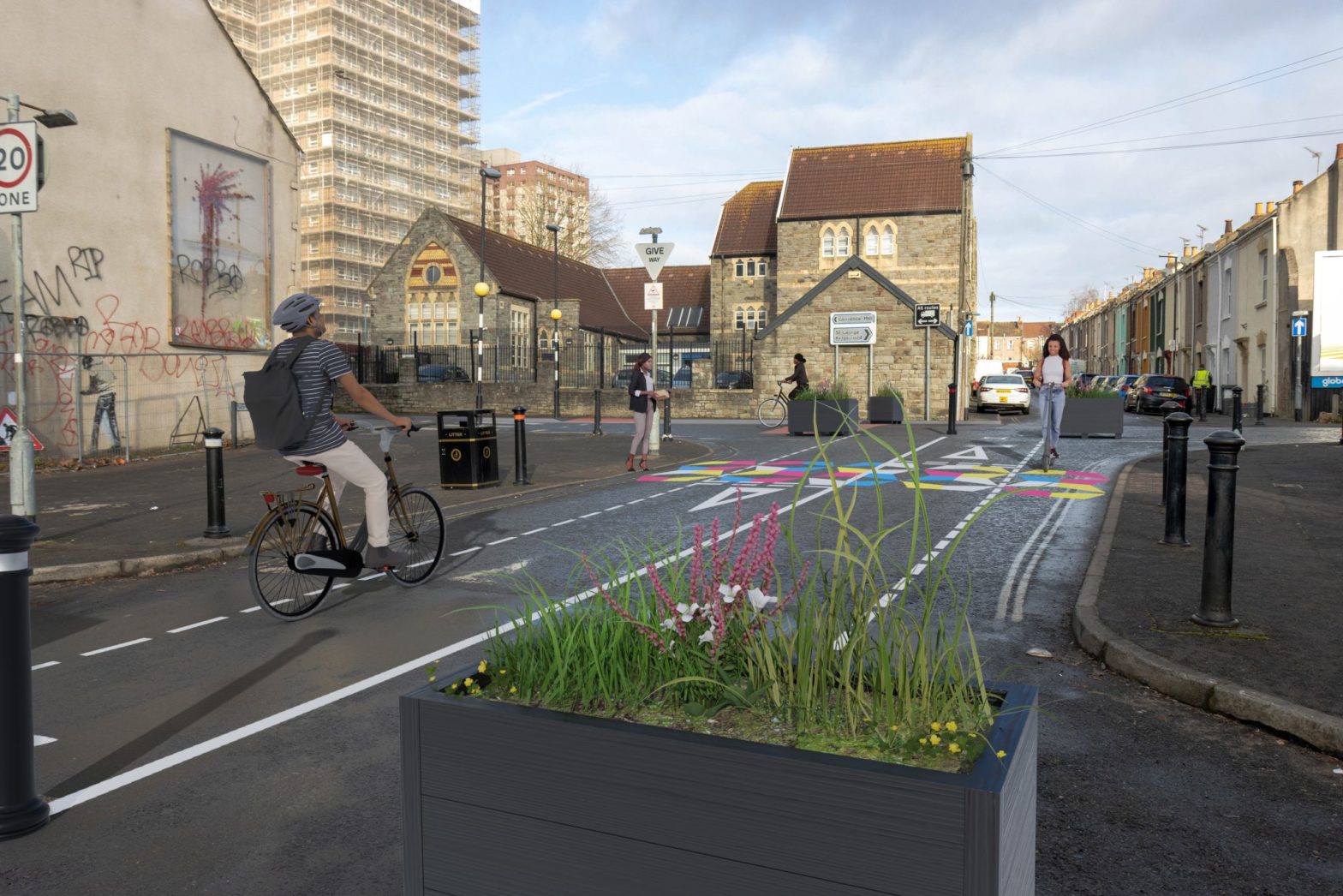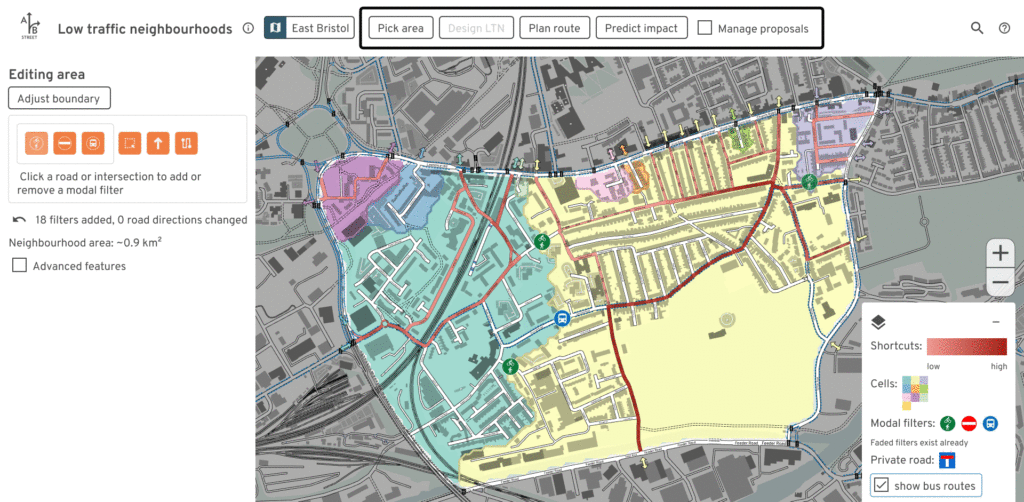
Photo: Bristol City Council
Bristol set to introduce low-traffic neighbourhoods after public consultation
15 March 2024
by Christopher Carey
Efforts to reduce congestion in UK cities have taken something of a battering lately, with so-called Low Traffic Neighbourhoods (LTNs) becoming the subject of intense criticism online and in some media circles.
The concept – which essentially involves placing strategic barriers on certain residential roads to discourage private car use – has been dubbed a ‘war on motorists’ by some, and council meetings on the topic have increasingly become heated.
With elections in the UK looming, and the opposition Labour party already suffering a byelection defeat attributed to the Mayor of London’s expansion of the Ultra Low Emissions Zone, the implementation of any policy that appears to restrict access or charge people for using their car is a risky gambit.
Last week, London’s Lambeth council suspended one of its LTNs after months of delays to buses.
The council said the combination of the scheme and frequent roadworks had caused a “significant strain on bus services”, and added it would be paused due to local concerns and upcoming construction projects in the area.
While some schemes have garnered controversy, a report leaked to The Guardian last week suggested that overall twice as many local people living within LTNs supported the measures than opposed them.

The surveys of over 1,800 residents across four sample schemes in London, Birmingham, Wigan and York, found an average of 45 percent in support and 21 percent opposed.
Speaking to Cities Today, Bristol’s Cabinet Member for Transport, Don Alexander said he believes the potential benefits far outweigh the risk.
The city is currently analysing over a thousand responses it received from a public consultation on its planned LTNs, which it has dubbed ‘Liveable Neighbourhoods’, that aim to reduce congestion and promote behaviour change.
“We’re looking at introducing a number of measures – it’s about taking the opportunities you get from not having a high number of cars on residential streets,” said Alexander.
“Nobody is excluded from having a car or from using a street but some [streets] will be closed at one particular end in order to reduce car usage, and then the extra space that’s created can be used for pocket parks, sustainable drainage for trees or bike hangars, and actually just to create a better environment for walking and cycling.
“Some of these roads actually have quite poor pedestrian provision anyway, as they are very old streets with narrow pavements, and you have two busy lanes of cars so actually it just means that people don’t socialise here or even think of cycling with their kids to school.”
Addressing the criticism
While some criticisms of LTNs in England have been exaggerated and linked to wider conspiracy theories, some also have merit.
A July 2023 report on Oxford’s LTNs found that emergency vehicles in the city could be delayed by up to 45 seconds.
The simulation data from Oxfordshire County Council was released as part of a consultation on the trial scheme which has since been made permanent.
Other councils have encountered similar problems with emergency vehicles being unable to access streets due to restrictions in place, with dozens of videos circulating online purporting to show ambulances and fire engines being blocked.
When asked about how Bristol was approaching this issue, Alexander said that some of the backlash was unjustified.
“I’m always concerned about that, if it’s based on solid evidence of emergency vehicles not actually being able to get to a certain place.
“But there are questionable pieces of evidence being created [by Liveable Neighbourhood opponents] as part of a campaign which I think is more ideologically motivated than evidence based.
“We work with the emergency services [in planning] and they absolutely need to be satisfied with the arrangements we’re putting forward.
“There’s nowhere you can’t reach – you may have to reach it by a different direction or street, but the emergency services are aware of that.”
In terms of how the council has communicated its plans with residents in the midst of such a charged atmosphere, Alexander said it was important to be context specific and know your audience.
“It’s quite difficult to learn from the experience of other cities like London for instance, which has a very good public transport system in place, and the underground, which is very different to Bristol.
“You have to use a lot of different methods [to engage with residents]. There are still some people who are not very familiar with the internet and can only be reached through more traditional methods. But at a certain point, people are quite committed to their own viewpoint, or they might not be interested.
“There is always going to be a point with these radical transport projects where a political decision has to be made, which isn’t always going to cover the politician in glory.”
Turning to tech
To understand residents’ views, the council launched a three phase process: co-discover, co-develop, and co-design.
First, they collected feedback through online citizen engagement platform Commonplace on residents’ current experiences of their neighbourhood, aggregated on a digital map.
They then invited residents to attend virtual and in-person sessions to learn about the different street design options and to propose ideas based on their priorities.
To reach people who may not typically attend public consultations, such as those new to the UK or who don’t speak English as their first language, the council worked directly with community volunteers and printed materials in multiple languages.
As part of the engagement process, the council also partnered with the Alan Turing Institute to create a dashboard where residents could explore different scenarios to help understand how access may change once the pilot is in place.

“[The dashboard] helps you to divide up an area and shows you how, in a sense, you can address rat running by blocking off access to certain roads at certain points, and for some people that’s really interesting.”
When looking at a start date for the scheme, Alexander said he believed it could be up and running by autumn, but also that it was important not to rush things and ensure people were onboard.
“Taking things slowly is part of it actually, because bedding behaviour change is at the heart of this [scheme].
“There is nothing radical about it technologically or from a design perspective, it’s about people behaving differently. So taking time isn’t a problem.
“We’re looking at one year for an experimental scheme, and then making it permanent if it works okay, and possibly with some changes.
“I don’t think there’s any virtue in trying to push it faster because it’s primarily about behaviour change.”










